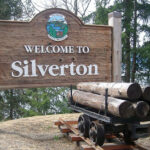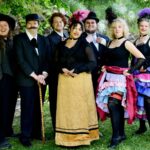A Walk in the Forest Serious Work for Selkirk College Forestry Students
A Walk in the Forest Serious Work for Selkirk College Forestry Students
CASTLEGAR – You’ve got to get an education to have a career in forestry management these days. But it’s still important to see how things work in the “real world”—especially if it’s a different world from the one you’ve been learning about in the classroom for the last two years.
That’s why 26 second-year students from Selkirk College’s Forestry Technology Program took part in the school’s annual field trip to Vancouver Island in March. There they spent a week hiking and exploring ecosystems quite different than the West Kootenay terrain where the program is based.
“Coastal forestry is quite different from Interior forestry in many ways,” says Jesper Nielsen, an instructor with the Forest Technology Program. “The trees grow bigger and faster, the vegetation is different and the terrain is tougher.”
“The students gain a very good familiarity with Interior-based operations during their two years here at Selkirk,” he adds. “Even though most of them will end up working in the Interior, it’s important for them to see forestry through as many different lenses as possible.”
The class spent a week learning about mainstream and alternative forest harvesting, and management practices in the province’s coastal rain forest region. The students were introduced to industry practices from seed propagation in Surrey to forest tourism and extreme road building techniques on Vancouver Island.
“It’s all beautiful, but the old-growth trees are by far the most impressive,” says Luke Erridge, a 23-year-old student originally from Ontario. “It’s hard to understand the sheer scale and size of the operations out there. Not only the size of timber, but with the increased revenue out there, they are able to put in extremely costly and difficult roads… it’s super-impressive.”
While the forest industry was the focus of the event, the class also took time to appreciate the natural beauty and wonder of the old-growth forest. Students hiked to the ancient Avatar Grove near Port Renfrew and the giant Sitka Spruce stands of the Carmanah Valley. They also spoke with a member of the Dididaat First Nation about aboriginal land, traditional practices and forest values.
“Our Aboriginal class really teaches upcoming foresters about Aboriginal culture and proper respect towards First Nations’ values and traditions,” says Erridge. “It has really prepared us for working with aboriginal groups.”
Field trip is Bittersweet for Instructors
The field trip is one of the last major courses to be completed by students in the two-year program. After that, Nielsen and his fellow instructors send the students out into the world. It gives the whole field trip experience a wistful flavor for him.
“They’ll all graduate shortly, at which time they’ll become my colleagues, rather than my students. The sad aspect is that this is also the part where they leave and scatter to all parts of the province,” says Nielsen. “This trip makes my relationship with each of them feel more complete before that happens.”
“The best thing I learned on the trip was a little something from all my classmates,” agrees Erridge. “The trip was not only an excellent educational experience, but it allowed for our entire class to bond. It was nice having a good time with people I don’t usually see outside the classroom.”
Students will be busy getting caught up in their careers very quickly. Work is everywhere for the willing graduate, says Nielsen.
“The forestry profession is entering a major transitional period, with many current foresters on the cusp of retirement,” says Nielsen. “Analysts project a significant shortage of new entrants to fill the positions that these veterans will vacate. Essentially, every graduating Forest Technology Program student who wants a job in the profession they’ve been trained for will end up with one.”
While the field trip is part of the regular course curriculum, students traditionally raise additional money on their own to enhance the experience. Local businesses help students fundraise through donations and hiring students as tree planters. Organizers want to thank Brent Petrick of Kelly Creek Logging, Atco Forest Products, Nakusp and Area Community Forest and local forester Pat Cutts of Brisco Wood Preservers for their support.


























Comments